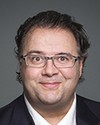Good afternoon.
I'm a front-line physician practising in Brampton and Milton, Ontario; a medical educator; and the co-founder and president of Concerned Ontario Doctors.
I thank you for the opportunity to address the Commons standing committee on health about your study into the violence faced by Canada's front-line physicians on behalf of Concerned Ontario Doctors, a grassroots, not-for-profit organization representing nearly 11,000 community and academic family physicians and specialists across Ontario. We advocate for a patient-centred, sustainable, accessible and high-quality health care system.
Canada's health care system was once a source of great pride for our country. It is unfathomable that we now rank third last for accessibility to patient care amongst all the wealthiest nations in the world. Ontario is in the midst of an historic health care crisis, with Ontario's doctors now into our eighth unprecedented year of billions of dollars in deep cuts to our essential front-line patient care, leaving more than one million patients in Ontario without a family doctor, creating province-wide emergency room gridlock, and causing wait times to explode, with some specialists' wait times rising to up to three years. Patients are increasingly projecting their frustrations and anger with the broken health care system onto front-line doctors.
The World Health Organization defines workplace violence as “the intentional use of physical force or power, threatened or actual, against another person or against...a group of people, that results in or has a high likelihood of resulting in injury, death, psychological harm, maldevelopment, or deprivation.”
Health care is known to have the highest incidence of workplace violence. Ontario's nearly 29,000 physicians provide essential medical care to Ontario's 14 million citizens, with more than 300,000 patients cared for by Ontario's doctors every single day. It is crucial that governments address violence against front-line physicians in all aspects of front-line patient care delivery, from hospitals and long-term care homes to community clinics and home visits.
Canadian physicians working in hospitals and psychiatric ER departments and in after-hours clinics have an increased risk of encountering an abusive and violent patient, as do physicians making house calls and those who treat large numbers of patients with mental illness and addiction.
The majority of Ontario's front-line physicians face increased risks of violence in providing care in medical and walk-in clinics within the community. When de-escalation attempts fail, the only option that exists—often after the violence and abuse has already occurred—is for the front-line secretarial staff and doctors to call police. Front-line physicians have reported violence ranging from verbal abuse, racism and sexual harassment to physical violence, including patients spitting, biting, kicking, groping, punching, stabbing and assaulting physicians.
In a 2010 survey of Canada's family doctors, approximately one-third reported having endured aggressive behaviour from a patient or a patient's family member in the previous month. During their career, 98% reported at least one abusive incident. Of those, 75% were major incidents, such as sexual harassment, whereas nearly 40% were severe, such as sexual assault or stalking. The results varied for female physicians working on-call. Female physicians' sense of safety decreased dramatically to 7.2% during on-call duties, compared with male physicians at 75%. Of the physicians who experienced an abusive event in the previous month, 55% were not aware of any policies to protect them; 76% did not seek help, and 64% did not report the abusive event.
Physicians are increasingly experiencing cyberstalking and cyber-bullying by patients. In a recent Medscape survey of physicians in North America, nearly 40% of doctors reported online abuse. More patient hostility has been associated with online anonymity.
The National Academies of Sciences, Engineering and Medicine's 2018 report on women found, shockingly, that sexual harassment of women is most prevalent in medicine of all STEM fields, because in medicine, the harassers are colleagues, supervisors, staff and also patients. Four key factors were identified in the reports as creating higher levels of risk for sexual harassment in medicine. These included men having positions of power and authority, organizational tolerance of sexual harassment, hierarchal relationships, and isolating environments.
As many as 50% of female medical students report experiencing sexual harassment. Many research studies and reviews describe a culture of harassment in medicine, which has long-term implications for the profession, including significant reductions in professional, psychological and physical health. In Canada, most medical students are now women, and medicine now has a greater representation of people of colour within the profession than in the general population. However, women and people of colour occupy only a tiny fraction of leadership positions. It is the toxic culture within medicine that pushes women and people of colour out of leadership positions and that creates glass ceilings.
Violence against front-line physicians is associated with increased stress, burnout, addiction and risk of developing mental health illness, including depression, anxiety and suicidal ideation. It may also result in absences or refusal to work in high-risk areas and poorer patient outcomes. This is deeply concerning, as the burnout rate reported by Canada's nearly 87,000 physicians is now at 50%, and Ontario’s physicians have a historic burnout rate of 63%.
Medicine has the highest suicide rate of any profession. This is an alarming public health crisis. The physician suicide rate is already more than twice that of the general population, with male doctors killing themselves at a rate that is 40% higher than of men in the general population, and female doctors killing themselves at a rate that is 130% higher than of women in general.
Ironically, physicians’ provincial and territorial regulatory and licensing bodies do not recognize mental health and physical health as being equal. One of the greatest barriers to physicians receiving the mental health care they so desperately need remains mandatory reporting to provincial and territorial regulatory and licensing bodies. The majority of front-line physicians suffer in silence, fearing the implications for their medical licence and their livelihood of reporting.
Canada is entering uncharted territory, with our senior population projected to grow by 68% over the next 20 years. With our health care system already stretched well beyond its limits due to deep cuts and heavy rationing of front-line patient care, violence on the front lines of Canada's health care system will only escalate.
The Government of Canada has the opportunity to provide a strong leadership role in bringing collective change across provinces and territories. Concerned Ontario Doctors has 11 key recommendations.
One is a zero-tolerance policy toward workplace violence and harassment on the front lines of Canada's health care system.
Two is a universal definition of workplace violence.
Three is visible security and surveillance for workplace violence in hospitals, mental health facilities and long-term care homes, with formal reporting processes protecting against reprisals.
Four is development of comprehensive strategies to address the safety of physicians practising within community and walk-in clinics, providing home care visits and overnight on-call care, with formal reporting processes protecting against reprisals.
Five is that medical school and residency curriculums include mandatory training on approaches to de-escalation when encountering sexism, racism, harassment, verbal abuse and physical abuse from patients.
Six is that provincial and territorial medical regulatory and licensing colleges develop policies to address situations of sexism, racism, harassment, verbal abuse and physical abuse from patients against medical trainees and physicians and ensure that these policies are in line with the respective provincial-territorial human rights codes.
Seven is to ensure that front-line doctors have democratic representation that is accountable and transparent. According to OECD experts, harassment and corruption flourish and create a toxic environment when there is monopoly power. Ontario is unique in having a provincial medical association granted mandatory government-legislated dues from all physicians. That has created an untenable situation. Governments have a responsibility to protect patients and physicians, and to address toxicity and lack of democratic representation by repealing such legislation and undertaking an independent forensic review.
Eight is whistleblower legislation to protect physicians and all health care workers when they reporting wrongdoings impacting front-line and patient safety.
Nine is the creation of a front-line health care ombudsman, similar to that of other countries such as Australia, to allow for confidential reporting and to have a mandate to protect front-line workers.
Ten is that all levels of governments should address the alarming physician burnout and suicide epidemic.
Eleven is amendments to the Criminal Code to allow its provisions to apply to physicians, nurses and health care workers who are subjected to workplace violence, similar to those that already exist for transit workers and police officers.
Lastly, violence against front-line physicians, nurses and health care workers is a complex and multi-faceted societal problem that demands a comprehensive and multi-pronged approach, which is only possible with all of us working together.







